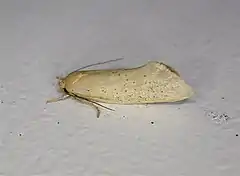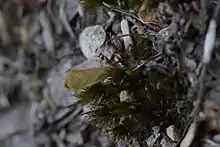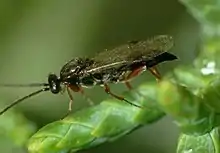| Tingena armigerella | |
|---|---|
 | |
| Scientific classification | |
| Domain: | Eukaryota |
| Kingdom: | Animalia |
| Phylum: | Arthropoda |
| Class: | Insecta |
| Order: | Lepidoptera |
| Family: | Oecophoridae |
| Genus: | Tingena |
| Species: | T. armigerella |
| Binomial name | |
| Tingena armigerella | |
| Synonyms[2] | |
| |
Tingena armigerella is a species of moth in the family Oecophoridae. T. armigerella is endemic to New Zealand where it is found in the North Island. The larvae of this species feed on plant litter. It is parasitised by the parasitic wasp Fustiserphus intrudens.
Taxonomy
It was described by Francis Walker in 1864 and named Oecophora armigerella.[3][2] In 1915 Edward Meyrick placed this species within the Borkhausenia genus.[4] George Hudson discussed and illustrated this species in his 1928 book The butterflies and moths of New Zealand under the name Borkhausenia armigerella.[5] In 1988 John S. Dugdale assigned this species to the genus Tingena.[2] In the same publication Dugdale also synonymised Tingena bifaciella with this species.[2] The holotype specimen, collected in Auckland, is held at the Natural History Museum, London.[2] In 2004 the phylogenetic relationship of this species to similar species was studied.[6]
Description
.jpg.webp)
The larvae of this species are dark brown coloured.[7]
The male adult was described by Walker as follows:
Male. Gilded yellow. Palpi nearly twice longer than the breadth of the head ; second joint much curved ; third shorter than the second. Abdomen, hind wings and under side blackish cinereous. Abdomen extending a little beyond the hind wings. Hind tibiae fringed. Fore wings moderately broad, hardly acute, with many minute blackish points ; costa blackish towards the base. Hind wings blackish. Length of the body 3 lines ; of the wings 10 lines.[3]
The forewing length of the species is between 7.5 and 10 mm.[7] Although there are several other endemic to New Zealand moth species that resemble T. armigerella, this moth can be distinguished from most others by the smattering of dark scales on its mainly yellow forewings.[7]
Distribution
This species is endemic to New Zealand.[1] It is found throughout the North Island.[7] It is visually very similar to other yellow species of moth but differs from many of these as it has noticeable dark scales on its wings.[7] It has been hypothesised that observations of T. armigerella in the South Island result from misidentification with these visually similar yellow species.[7]
Habitat and hosts

This species inhabits native forest.[7] Larvae feed on plant litter found in Nothofagaceae forest.[8] The larvae are found in between the upper layer of dry loose leaves and the lower layer of compacted moist soil.[9] They live in a shelter they construct with their silk, tying two dead leaves together.[9] The larvae then feed from this shelter.[9]
Behaviour
The adults of this species are on the wing from October to February.[10] They prefer to rest on tree trunks or fences and when disturbed, fall to the ground and seeks shelter in crevices or alternatively rests on their back with wings closed.[5] They are nocturnal and are attracted to light.[7]
Enemies

The parasitic wasp Fustiserphus intrudens parasitises the larvae of this species.[9]
References
- 1 2 "Tingena armigerella (Walker, 1864)". NZOR.org.nz. Landcare Research New Zealand Ltd. Retrieved 16 October 2016.
- 1 2 3 4 5 Dugdale, J. S. (1988). "Lepidoptera-annotated catalogue, and keys to family-group taxa" (PDF). Fauna of New Zealand. 14: 1–264 – via Landcare Research New Zealand Ltd.
- 1 2 Walker, Francis (1864). "Tineites". List of the Specimens of Lepidopterous Insects in the Collection of the British Museum. 29: 563–835 – via Biodiversity Heritage Library.
- ↑ E. Meyrick (12 July 1915). "Revision of New Zealand Tineina". Transactions and Proceedings of the New Zealand Institute. 47: 212. ISSN 1176-6158. Wikidata Q63123349.
- 1 2 Hudson, G. V. (1928). The Butterflies and Moths of New Zealand. Wellington: Ferguson & Osborn Ltd. p. 264. OCLC 25449322.
- ↑ Kaila, Lauri (August 2004). "Phylogeny of the superfamily Gelechioidea (Lepidoptera: Ditrysia): an exemplar approach". Cladistics. 20 (4): 303–340. doi:10.1111/j.1096-0031.2004.00027.x. ISSN 0748-3007. PMID 34892939. S2CID 86113904.
- 1 2 3 4 5 6 7 8 Hoare, Robert J. B. (2014). A photographic guide to moths & butterflies of New Zealand. Olivier Ball. Auckland. p. 33. ISBN 978-1-86966-399-5. OCLC 891672034.
{{cite book}}: CS1 maint: location missing publisher (link) - ↑ "PlantSynz - Invertebrate herbivore biodiversity assessment tool: Database". plant-synz.landcareresearch.co.nz. Retrieved 2018-07-16.
- 1 2 3 4 Early, J. W.; Dugdale, J. S. (January 1994). "Fustiserphus(Hymenoptera: Proctotrupidae) parasitises Lepidoptera in leaf litter in New Zealand". New Zealand Journal of Zoology. 21 (3): 249–252. doi:10.1080/03014223.1994.9517992. ISSN 0301-4223.
- ↑ Alan Emmerson; Robert Hoare (28 October 2019). "Lepidoptera from Redvale, Albany, north of Auckland, New Zealand, 2004-2016: an annotated list". The Wētā. 53: 43–70. ISSN 0111-7696. Wikidata Q105342215.